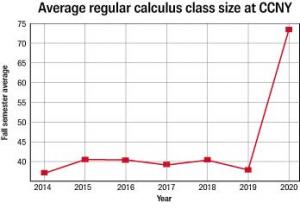Class size is “on average lower than it has been in the last six years” across CUNY. At least that’s what CUNY Chancellor Félix Matos Rodríguez and CUNY Board of Trustees Chair William Thompson told eight members of Congress who had expressed dismay at the mass layoffs of adjuncts at CUNY.
 |
When Clarion asked CUNY for this semester’s average class size, and the number for the past six years, administration spokesperson Frank Sobrino said only, “CUNY’s student-faculty ratio is consistent with those of other university systems across the country.”
NOT AN ANSWER
That’s not much of an answer. As for the student-faculty ratio, and the names of other university systems to which CUNY’s student-faculty ratio is comparable, Clarion asked that too – no response from CUNY.
For many PSC members, classes aren’t shrinking. Course caps for online classes at BMCC and BCC went up from 25 to 30. Department chairs at Brooklyn College felt pressure to increase class size because of administration directives to reduce the number of sections by a targeted 25%, and several departments at City College have increased their class caps significantly, according to PSC activists.
Looking at average class size system-wide only tells a fraction of the true story. Certain classes could have shrunk while others increased dramatically – and those classes with the increases suffer tremendously. “The average isn’t the right number to express the experience of an individual,” said Sharon Persinger, PSC Treasurer and associate professor in the Department of Mathematics and Computer Science Department at BCC. “Even if the average number of students per section is 26, let’s say, that student who is in a section of 50 and the instructor who teaches that section of 50 are experiencing a course with 50 students in it. The student gets a smaller share of the instructor’s attention and the instructor has a higher workload than if the course had 26 students.”
 |
A professor at City College crunched CUNYfirst data for the Fall semester average calculus class size at the college, a basic requirement for many STEM majors (see graphs). And contrary to what Matos Rodríguez and Thompson found system-wide, he discovered a dramatic increase in the average number of students from 2019 to 2020. The average number of students for regular classes jumped from 37 (in 2014) to 74 (2020). And jumbo classes jumped from 84 (2014) to 126 (2020). That’s double the number of students for regular classes and a nearly 50 percent increase for jumbo classes since the Fall semester of 2014. “Practices vary across the campuses, but some colleges have an enrollment limit for a regular course,” said PSC Treasurer Sharon Persinger. “An instructor [in some cases] teaching a course with enrollment above this threshold – a jumbo course – gets additional workload credit hours for the course.” More and more students are being packed into these essential math courses, and both teaching and learning suffer. Not really a fact that you can brag to Congress about.
But CUNY management seems to take perpetual austerity as a badge of honor.
“We continue to do more with less to support our students,” wrote Matos Rodríguez and Thompson in their August 31 letter to members of Congress. “Even with roughly $64 million lost tuition revenue from a 4.4% drop in enrollment as of Aug. 25, we have continued to offer about the same number of sections as last Fall.”
MORE WITH LESS
Translation: CUNY workers are doing more work with less money and less support. Anyone involved – whether it’s teaching or learning – knows that remote instruction requires more work, not less. And more students in a class requires more work too. The union has pressed CUNY management for months to bargain around class size – and CUNY has yet to agree.
The union has launched a class size campaign, an issue that affects all members.
“Class size at CUNY, where 80 percent of undergraduates are people of color and most are working-class, is an issue of racial justice as well as academic integrity and professional workload,” wrote PSC President Barbara Bowen in a November 1 email to members.

